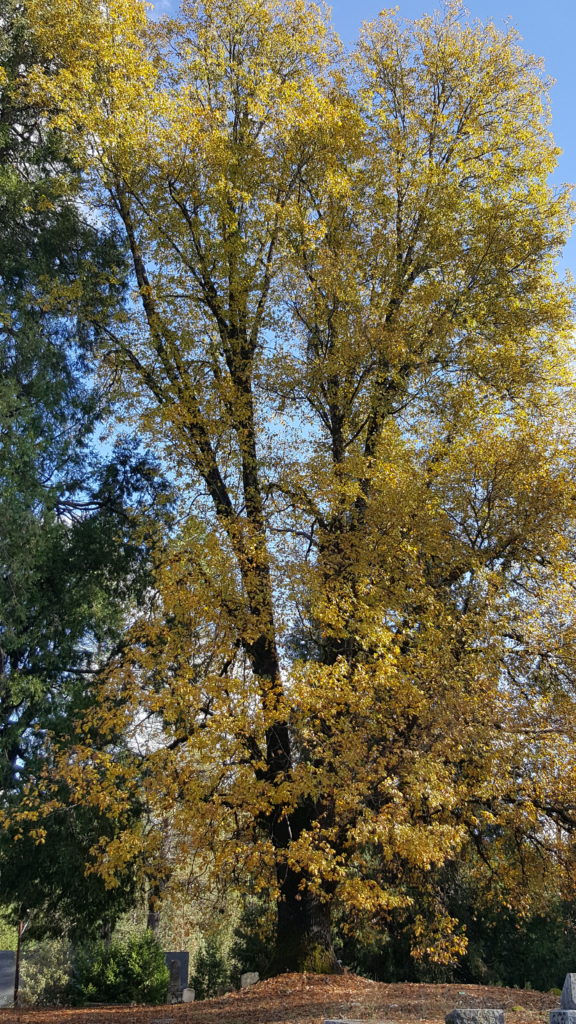Oak trees are iconic long-lived and enduring trees with their majestic form, large sweeping branches – sometimes with a picturesque asymmetrical balance, and massive trunks. Their leaves and acorns are also used as symbols, while acorns have been used as food by the Native Americans throughout California for millennia.
Oak trees may live for hundreds of years and it is said that they can die for a hundred years. When we move in among the oaks there a few basic things we do to accelerate the death of the established oaks around us. We build, we add water, and we try to make our landscapes look like something from a different land.
The native oaks are critical to wildlife, from insects to bears, providing food and shelter. Thousands of insects eat the leaves, branches, and acorns. In turn these insects feed birds and are especially important to the feeding of nestlings. Deer and bear rely on acorns to help fatten up for the winter. Entomologist and author Douglas Tallamy states that the single most important thing we can do to help wildlife is to plant a native oak.
The sturdy oaks are both tough and sensitive at the same time and how we landscape, garden, and build around them can be deadly to them. Native oaks have evolved to live in harmony with our Mediterranean type climate, characterized by cool, wet winters and hot, dry summers. They develop root systems over the course of decades that do not need watering in the summer. Most of the roots are within the top two to three feet of soil; they provide structural support for the tree and tis root zone extends out one and a half times the distance from the trunk as the canopy of the tree does. The edge of the canopy is called the drip line.
Scientists have been telling us for a long time that there are several things we should not do to the oaks on our properties and that lie in our urban spaces. It is that highly evolved root system that needs to be treated delicately. According to the University of California Agriculture and Natural Resources publication “Living Among the Oaks”, there should be no development within the root zone. “This means no grading, digging, trenching, using of fill soils, covering the ground with asphalt or concrete, or landscaping with plants that require more than two or three summer waterings.” Also, no heavy traffic that compacts the soil, and keep the natural leaf litter and fallen twigs and bark. Lawns should be outside of the root zone. If disturbances are unavoidable, at the very least, it should be kept as far away from a tree’s trunk as possible, preferably at least six feet.
Compaction and covering of soil within the root zone affects the gas exchange the roots need. As I stated, the root systems are delicate, representing a few millennia of evolution to graciously survive in dry summers.
Planting water needy plants under oaks encourages oak root fungus, also known as Armillaria. The fungus is one of the most widespread plant diseases in California. It does not like dry soil, and proliferates most rapidly under warm, moist conditions, aka summer watering! This fungus kills the oaks and many other landscape plants as well. The fungus may be well established before any indication of its presence is noticed and may take many years to be noticeable, but can cause the tree to decline quickly. The fungus is actually present among many native oaks but it is not until the tree is stressed that it begins to rot the roots, proliferating most quickly in warm, moist conditions.
So the answer to avoiding courting oak root fungus is planting plants that require only one or two waterings during the summer. Sounds impossible? There are many Californian and other Mediterranean-type plants that will work. The Sunset Western Garden Book has a section on suitable plants for planting beneath oaks. Here are some of the ones I like to use:
Evergreen Currant (Ribes viburnifolium) a low, sprawling shrub-like plant, evergreen, 2-4 ft. tall and up to 10-12 ft. wide, a California native,
Red Flowering Currant (Ribes sanguineum) a very handsome deciduous native shrub with gorgeous pink flowers in the spring, berries for the birds and fall color, 5-12 ft. tall and wide,
Toyon (Heteromeles arbutifolia) that lovely large native shrub with the berries turning red in the fall and winter, 8-15 ft. tall and wide, evergreen, the flowers feed the pollinators in the summer,
Deer Grass (Muhlenbergia rigens) a very tough, striking, native grass that can take full sun to quite a bit of shade, 3-5 ft. tall and wide, and
California Fescue (Festuca californica) another native grass, 2 ft. tall and wide, with delicate blue-green foliage.
Take proper care of your oaks if you have them. It has been demonstrated that they increase property value, by 7-30%, because as the Native Americans sought to live among the oaks, we still do today! The cooling shade they provide is not easily replaced. If we insist on having our water needy plants under the oaks, we may soon have neither the oaks nor the plants beneath them. The aesthetic would be short-lived.
For more information, see publications from the University of California, Agriculture and Natural Resources, see “Why are Oaks Important”, “Living Among the Oaks” and others; californiaoaks.org of the California Wildlife Foundation, see “Oak Tree Care”, “Guide to Sacramento Oaks” from the Sacramento Tree Foundation, and ca.gov Forest Stewardship Program “Oak Woodlands”.

